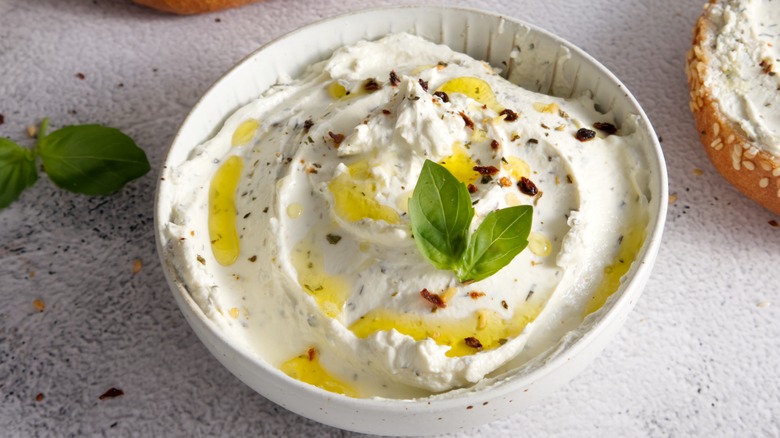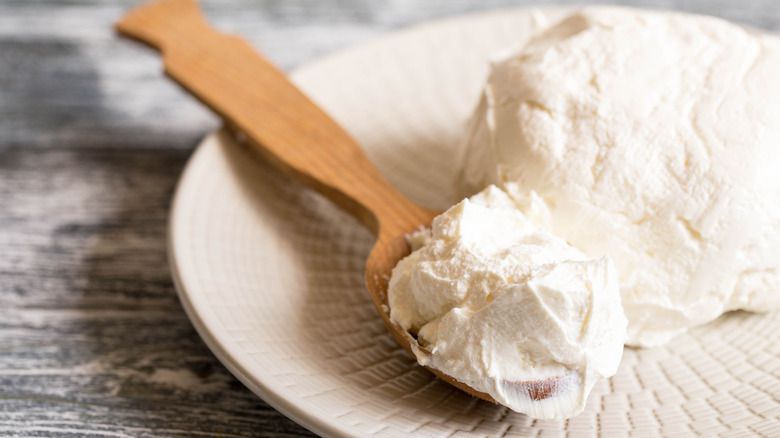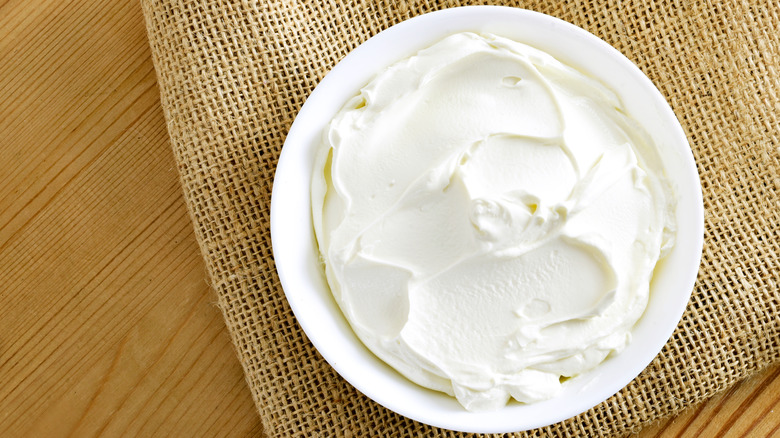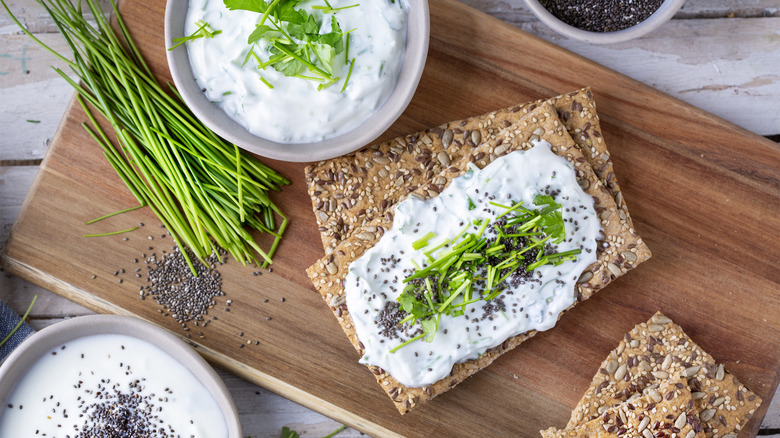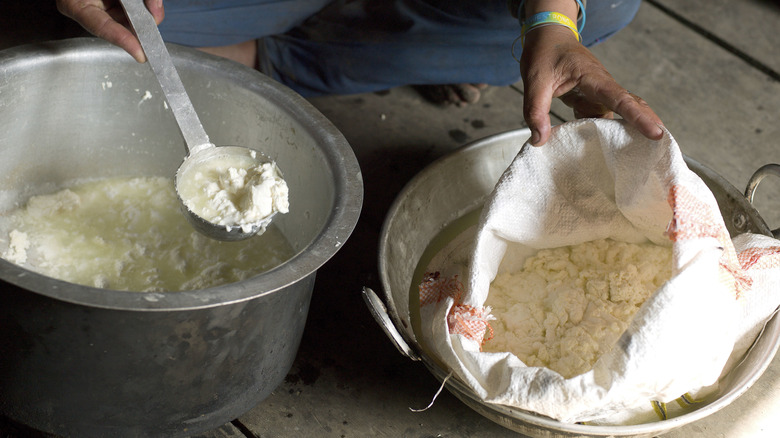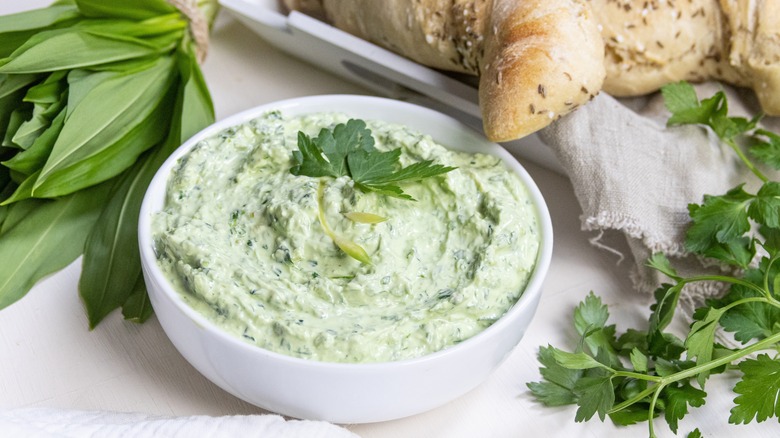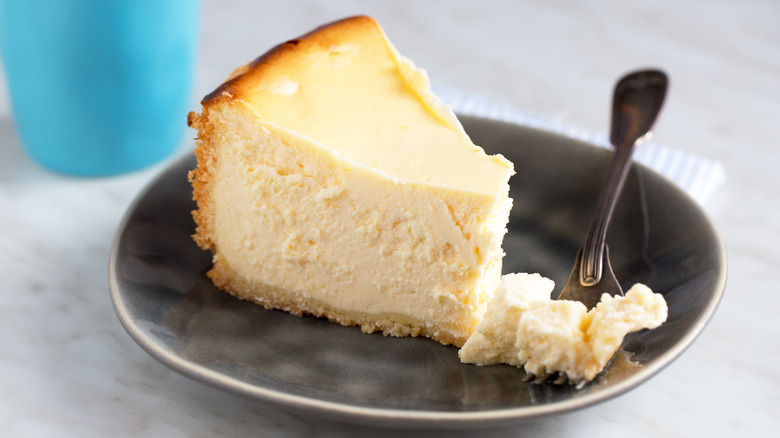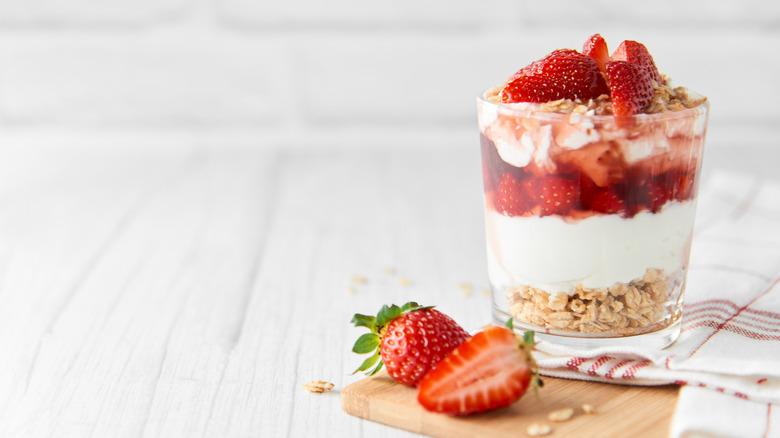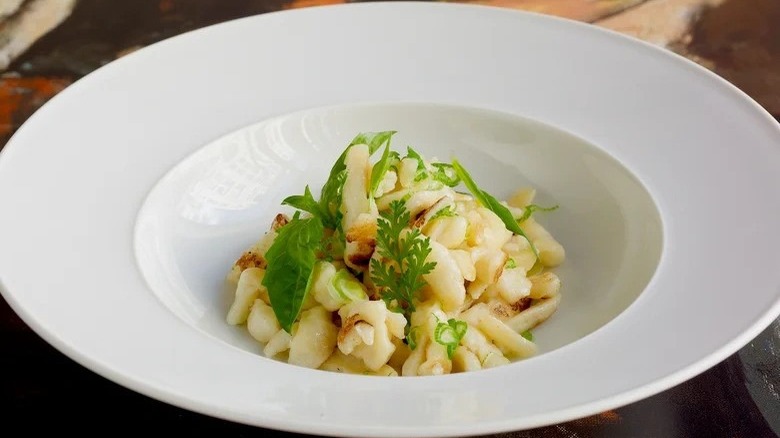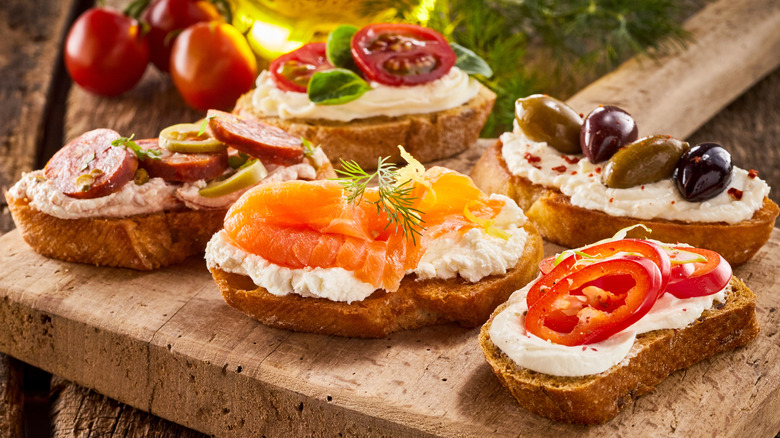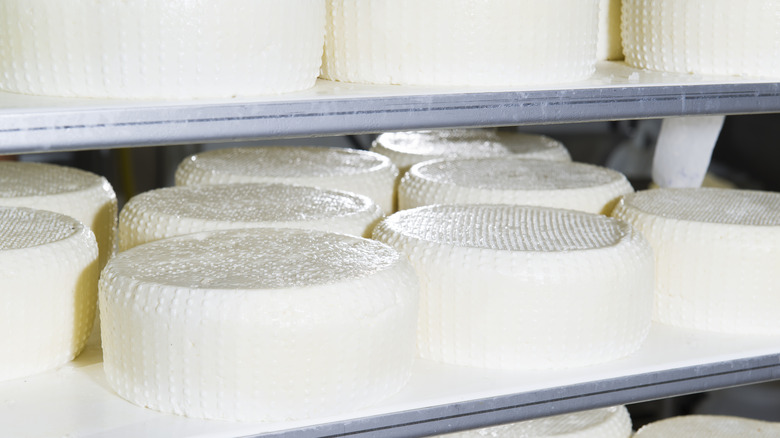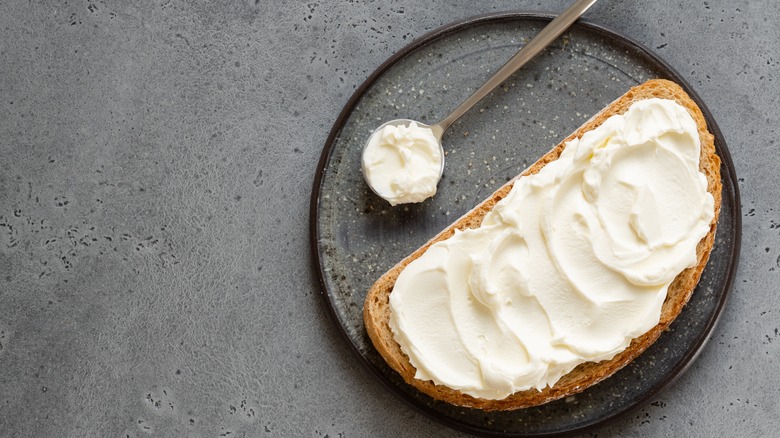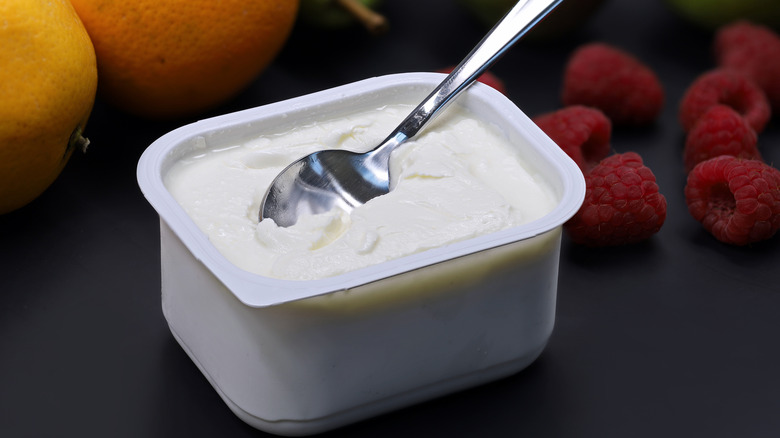What Is Quark And How Do You Eat It?
In the culinary pantheon, cheese is right up there in the heavens, on the mountaintop of flavor. It's incredible that such a simple process as cheesemaking can yield such a wide variety of products for both savory and sweet dishes. But if you've found yourself falling into the rut of picking up the same block of Colby Jack or bag of shredded mozzarella cheese every time you hit the store, it might be time to broaden your horizons.
Quark is the perfect foray into this exploration of cheeses. It's a rustic cheese with many distant relatives but still in a category on its own. While a common staple cheese in parts of Europe, in the U.S., quark is a mystery wrapped in an enigma. It's not widely known, which makes it tricky to find, and many of the dairy products put forth as substitutes can't exactly capture quark's unique texture and taste.
It may not be easy to find in North America, but it's worth searching for. Quark cheese is a versatile and nutritious dairy product that can enhance the flavor and texture of a wide range of dishes. It has a mild taste and creamy consistency that makes it well-suited to cooking and baking. Here's everything you need to know about quark.
What is quark?
Quark is a spreadable soft cheese that's created in a similar process to cottage cheese, but with a few differences giving it a smoother, creamier texture. If cream cheese, cottage cheese, ricotta cheese, and mascarpone had a baby, the child would be named quark, with a texture and taste that combines elements of each of its dairy parents.
Quark is prevalent across Europe, but not specifically attributed to originating in any one country or region. Eaters in Germany, Austria, and Switzerland enjoy it and use it in sweet and savory dishes, as do diners in Eastern European and Scandinavian countries. Different countries have different names for this cheese — topfen in Austria and rahmquark in Switzerland are just two — and there are also regional variations in the method of production. Some of these methods create a quark cheese with slight differences that reflect that country's preference for texture and taste.
In the U.S., quark is sometimes called farmer's cheese, dry curd cheese, or Amish cheese. It's sold in small tubs, often still in its own whey. It's as white as the dairy milk that it comes from and can be found, in some cases, in skimmed versions with less than 10% fat (called magerquark in Germany) or with cream added to bump up the fat content. And good news for the adventurous but lactose-intolerant: Quark is lower in lactose than many other dairy products.
Is quark yogurt?
If you open your tub of quark, hoping to add some fruit and dive into it with a spoon, prepare to be disappointed. The texture of quark is closer to mascarpone or fresh ricotta, and sometimes even stiffer than those. Some varieties of quark may resemble strained Greek yogurt, but those are regional and not common. The richness of this dairy product also makes it challenging to eat it by the spoonful.
All the same, quark does have a few things in common with yogurt. Its ratio of fat to protein is similar to yogurt, while being lower in fat and higher in protein. This makes quark more closely related to yogurt than cheese, but there is another significant difference that further separates them: How they're made. Yogurt is made by adding live cultures to warmed milk, but quark is made by adding lactic acid along with rennet to milk. This produces a different flavor that is much milder than yogurt's trademark tang. Rennet is a relatively modern addition to quark production — it's used primarily when raw milk is not available, or when its use in food is not legally allowed.
What does quark taste like?
The taste of quark is best described as mild and creamy, with very little tang. It's usually unsalted and made from cow's milk (although it can be made from goat milk, too). One of the best qualities of this dairy product is that the taste is a blank, deliciously smooth canvas upon which to paint other flavors and textures. Quark is the perfect base note for a variety of dishes, adding body to sauces and a velvety smooth texture to desserts.
Again though, taste and texture may vary depending on the region. Some countries prefer a little texture in their quark — this means you might find small, cottage cheese-like curds sprinkled throughout. If you are looking for smooth texture, you can always blend the quark in a food processor with a little cream to incorporate these curds and loosen up the cheese.
Quark is also famously unsalted. Because of this, it's critical to make it with the highest quality milk. Plain Greek yogurt and Icelandic skyr have similar requirements — high-quality milk makes all the difference to the final flavor. In fact, quark's flavor can change appreciably from season to season as the grass and feed in a cow's pasture changes.
How is quark made?
Quark is a fresh cheese that is not aged but is used immediately after it's made. The simplest recipes combine warmed milk with buttermilk and allow the bacteria in the buttermilk to create curds in the milk. This only works if your buttermilk is not ultra-pasteurized, a heating method that destroys both bad bacteria that make you sick and good bacteria that make yogurt and cheese. If you cannot find unpasteurized or raw buttermilk, lactic acid and rennet are the way to go. Rennet can be found in vegetable or bovine form, and it's what helps the milk proteins come together into curds.
With both methods, the milk is heated slowly and held at a warm temperature (not boiling) until it curdles. The solids are then strained using cheesecloth. Here's where the cheese maker has some influence over the texture and the taste. The longer the curds are strained, the dryer and thicker the cheese is. For a creamy texture, cheese makers may add a small amount of cream. Salt is rarely — if ever — added to any version of quark.
If you've ever tried your hand at making homemade ricotta, quark is an easy next step. You need a few more specialized ingredients, but other than that (and the best-quality milk you can buy), the process is simple.
Are there different varieties of quark?
The different varieties of quark are directly tied to the region in which they're produced, with specific additions (and subtractions) based on that culture's preference. For example, Austrian quark is strained for longer until it has less whey and is much drier than its German counterpart, and quark in the Netherlands is more like an exceedingly thick yogurt, due to its use of yogurt-like bacteria and fermentation process.
After production, though, many countries have similar ways of flavoring their quark. German quark comes in a creamy variety with a higher fat content, made by blending the quark with double cream for a sweeter taste. Its smooth sweetness makes it ideal for desserts and baking, and this cream addition is fairly common when making quark for sweet dishes.
Quark also comes in flavored varieties like vanilla, fruit, or chocolate for dessert, and herbed or spiced quark for savory snacks. Still more varieties of quark don't include seasoning, relying instead on the terroir of the milk to create a unique flavor profile.
Using quark in desserts
Quark is good for all types of cooking and baking, but it really shines in desserts. Its luxurious texture and creamy mouthfeel are in line with what people expect in a dessert, and quark's mild flavor is a tabula rasa for cooks and bakers to work with. One of the most traditional uses of quark is in German cheesecake (käsekuchen), quite different from the more familiar New York- or even Basque-styles of cheesecake. A filling of quark, sugar, eggs, and vanilla pudding powder (plus a few other ingredients) is baked in a pastry crust then cooled and served as both an all-occasion and special dessert.
Quark can be used for much more than just cheesecake, though. Anywhere mascarpone is used would be a great place to try substituting quark. Try adding quark to your next tiramisu. Blend it with heavy whipping cream and make a fruit parfait. Use quark in your favorite icing recipe that calls for cream cheese and spread it on a deeply spiced cake.
Eating quark for breakfast
The simplest way to experience the charm of quark is to spread it on a warm piece of toast and top it with homemade jam or marmalade. If you've never had quark before, this is the best place to start — it gives you an idea of the texture and flavor so you can branch out and experiment. An easy option is to combine quark with a bit of cream or yogurt to loosen it up and create a breakfast parfait with granola and fresh fruit. Or, if you want to experience quark the way Russians and Ukrainians have for centuries, try syrniki for breakfast. These quark pancakes are made with very little flour. They're best served with a delicious dusting of confectioner's sugar, and a little applesauce or a bright, sweet jam.
For savory breakfast eaters, quark has you covered too. Stir a dollop of quark into your soft scrambled eggs for a luscious treat. Mix quark with scallions, chives, salt, and pepper, and serve with roasted vegetables and sourdough toast.
Quark: It's what's for dinner
Because of it's mild taste, many people don't consider quark when planning dinner. But that's a big mistake. Quark plays well with savory ingredients and can elevate simple food. Need a quick sandwich for a late dinner? Try Polish egg salad, substituting the cream cheese with quark.
For an impressive dinner with roots in down-to-earth food for the masses, try fresh herbed quark spaetzle. This is a beautiful fresh pasta made bright with herbs and luxurious with equal parts quark and ricotta. Alternatively, you can make a simple pasta with mushrooms and spaghetti by swirling quark, miso, and fresh thyme into heated pasta, or add a dollop into your penne alla vodka for a richer flavor. Sauce your cauliflower with quark, tahini, and plenty of lemons, and combine a heavenly quark dipping sauce with beets two ways (roasted and pickled) for a beautiful side dish.
You can even add quark to your ravioli filling or stuffed shells. Just remember though, no matter whether dinner is upscale or downtown, you should always cook quark in savory dishes over gentle heat. If you cook it too hot or fast, you may end up with a disappointingly curdled mess.
Is quark good for you?
The short answer? Yes. Per one-cup serving, quark has around 25 grams of protein and just one gram of fat. It's low in sodium, carbohydrates, cholesterol, and sugar, while also being packed with calcium and vitamins A and D. Quark is also low in calories, with 140 per serving (as compared with around 180 for a cup of Greek yogurt). Additionally, because it's low in lactose, many lactose-intolerant people find they can eat quark with no ill effects.
There is one big caveat to all of this. Because quark, as a food, has so many nutritional benefits, it's easy to consider that anything you make with it is healthy too. Don't make that mistake. Dessert is still dessert, and when you add sugar and other things like chocolate to quark, the nutritional profile of the end result changes considerably. As with all things, when used for dessert or in other usually high-calorie foods, moderation is key. Don't think you can devour that entire quark cheesecake with no consequences. On a bright note, though, if you're going to have dessert, a sweet breakfast, or decadent pasta, quark can add a bit of nutrition while decreasing the calories. This makes it an excellent part of a healthy diet.
Where can you buy quark?
When you're ready to explore everything the world of quark has to offer, be ready for a scavenger hunt. Because this soft cheese is not well known in the U.S., it's hit or miss which stores will stock it. The general recommendation is to start with upscale grocers that carry specialty items. This includes Whole Foods and Trader Joe's, both in stores and online. You can also try farm stands and perhaps Amish markets or other upscale, single-location grocers. Definitely call ahead to see if they stock quark or can order it for you.
Another great option is to search your area for European grocery stores, especially those that specialize in Russian and Austrian foods. In addition to selling imported packaged brands, some of these stores make their own quark onsite. This is an excellent way to sample the different tastes and textures of quark.
Finally, there are a few online retailers. Save yourself the currency conversion and exorbitant shipping by making sure they're located in the U.S.
Purchase quark at German Specialty Imports (based in Minnesota) for $14.95.
Purchase quark at The Creamery at Pleasant Lane Farms (Latrobe, PA) for $6.99.
Purchase quark at Bavaria Sausage, Inc. (southwestern Wisconsin) for $7.29.
What can you substitute for quark?
Good substitutions for quark range from Greek yogurt to cream cheese, but in reality, any substitution you make is not going to be 100% perfect. Quark has a mild flavor that's less tart than Greek yogurt, with a texture that's not always as stiff as cream cheese. Sour cream, another popular substitution, is a little too loose and tangy. The closest match in terms of both texture and flavor is mascarpone cheese.
Ultimately, though, the substitution that you choose depends on how you're planning to use the quark. For example, if you're planning on using quark to make a sauce, substituting a nice thick Greek yogurt is a good move. In recipes where you need a bit more body, like frostings or fillings, using mascarpone or even ricotta cheese is the best bet. Crème fraîche and fromage blanc are also viable options for a mild, neutral flavor.
When looking for a proper substitute, also consider the fat content of the recipe you're using and substitute accordingly. Quark has a relatively low fat content, so if you use a super fatty replacement that will affect your final product.
How do you store quark?
One of the reasons quark is so difficult to find across the United States is that it doesn't have an extended shelf life. While some dairy products can go many days or weeks past their use-by date, quark is more delicate and less tolerant of extended storage. This does, of course, depend on the production method — some packaging makes the product last longer.
Regardless of how it's made or packaged, quark should always be stored in the refrigerator and used before its expiration date. If you find yourself with an excess of quark and don't want it to go to waste, you can freeze it for roughly six weeks to three months. Be aware, though, that freezing and thawing will change the texture considerably — the quark will separate and become watery, and it loses its creaminess.
To freeze, portion your quark into ice cube trays, or otherwise into smaller increments, so you can thaw only what you'll use. If you use ice cube trays, pop the cubes out once frozen to keep in an airtight container. Thaw in the refrigerator — never at room temperature — to discourage the growth of bad bacteria. Stir the quark well once it's thawed. Just like with yogurt, the active cultures in quark stay alive through the freezing process, so you aren't losing any nutrition when you store it this way, although freezing also imparts a graininess that may not work in recipes that rely on its smooth texture.

